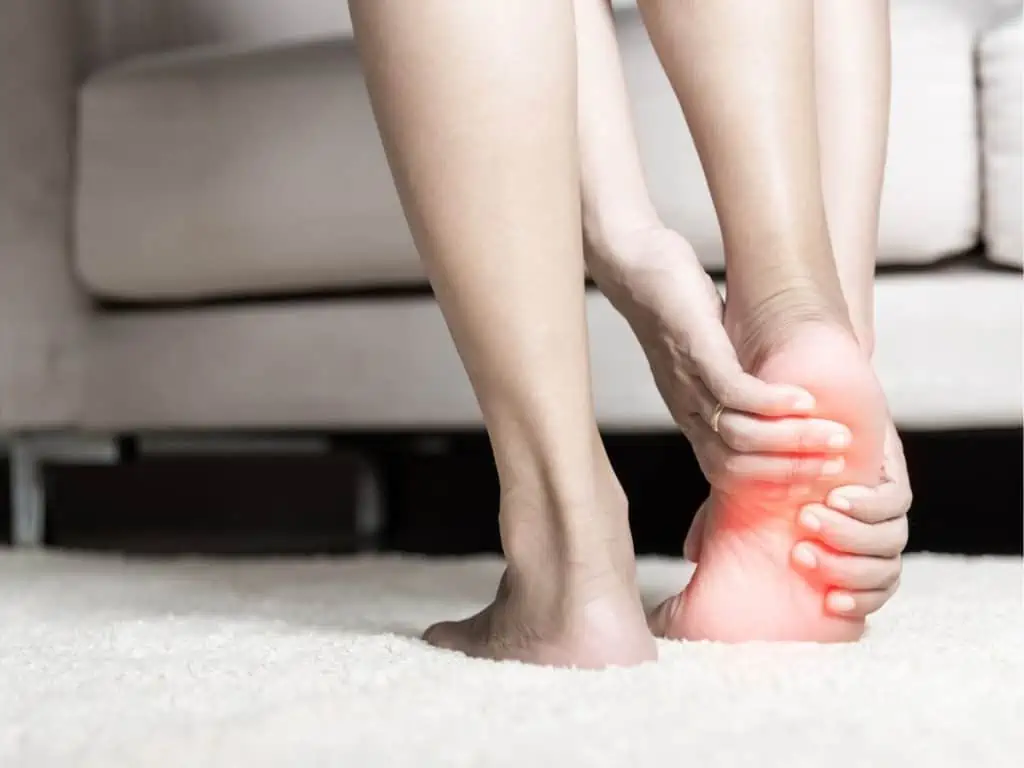The children or adults who are overweight are often the subject of foot pain. Their feet not only endure weight; joints and bones are subject to problem areas that include plantar fasciitis and heel spurs. Special sneakers with arch support produce a better performance. Athletes should specifically select well-designed, cushioned, and supportive sneakers — appropriate to the sport played — to limit pressure on feet and avoid foot problems such as broken or jammed toes, hammertoe, painful arches or plantar fasciitis. Some discomfort in the feet, the back or legs makes special orthotic shoe inserts advisable. There are many over-the-counter products that are very successful. If foot care problems are acute, a podiatrist should be seen.
WebMD shows you common foot problems — including corns, bunions, plantar warts, and athlete’s foot — and gives you answers for what you can do about them. Tiny, natural accumulations of moist skin, often appearing whiter than surrounding skin. Usually found on bony areas: the toes, tops of the feet, and sometimes the base of the heel. Treatment: Putting pressure on these with the thumb or gently with an orange stick. A doctor can also pare them down or give an injection to start the process. Heels on shoes should be 1-1.5 inches maximum; extra heel height slides the foot forward, cramping the toes and building pressure on the balls of the feet — making corns and calluses. Sneakers and boots to be used for hiking or running should not be overstressed so that they cause ball and heel pain. Work boots should allow feet some bend, not to stress the soles of the feet. Effective ball of foot pain treatment includes wearing cushioned insoles and practicing foot-strengthening exercises.
Understanding Foot Pain
A good starting point for understanding foot pain is the way we’re told to think about feet and footwear. Humans are shod beings. That means, throughout history, we’ve used devices to cover our feet when we’re on the move. The many parts of your foot, from your toes to your arches, from the balls of your foot to your heels, all have specific roles in the way we walk. That makes them vulnerable to pain from any number of sources. Think about all that skin, muscle, and tendons crammed into a small space. Think about the long distances we walk, the tremendous weight our feet have to support. Imagine the things we do: walking, hiking, playing sports, wearing high heels, through rain and snow and mud and dust. Considering all the forces that act on feet everyday, it’s no wonder they’re prone to pain.
Most foot pain can be linked to a handful of common problems. Understanding the problem is often the first step to finding relief. Foot pain can be as painful and frustrating as any other type of discomfort, and it can have a big impact on the quality of your daily activities. Considering the complex structure and ongoing stress we put on our feet, it’s no surprise that foot pain is so common. When you feel discomfort in your feet, the source isn’t always obvious. Just like issues with worn out or poor-fitting shoes, many of the most common foot complaints develop over time. But once the source is identified, you’ll likely find pain relief in a variety of treatments. Here are five of the most common types of foot pain. Understanding foot pain causes and treatment is essential, as it can stem from various conditions like plantar fasciitis or arthritis, each requiring specific approaches.
Common Causes of Foot Pain
As the foot ages, they start to experience a number of different foot diseases. Here are five general causes of sore feet, along with their symptoms and the treatment offered by an eye foot specialist at the Department of Veterans Affairs. Different biomechanical changes occur as we age including weakness and stiffness in all the foot structures like bones, muscles, and ligaments. Because of these changes, some people with lower arches may develop pain, stiffness, and severe arthritis throughout their foot. If not managed properly, these diseases can have a substantial psychological, social, economic and healthcare impact on older people. Despite these concerns, clinical evidence for the care of the foot in older people is scarce. Most studies that have been published contain low levels of evidence.
Your foot absorbs approximately 1,000 tons of force every day as you walk, run, and jump. The average person takes 8,000 to 10,000 steps a day, which adds up to about 115,000 miles over a lifetime. All this wear and tear can be harmful to your feet over time, meaning we tend to see a lot of people with foot pain. The good news is that most foot pain can be treated conservatively with simple, non-surgical methods to help reduce the strain on your feet and maintain or improve your mobility and posture. As you get older and the natural protective fat pads on the bottoms of your feet atrophy, you are more prone to having foot pain. Some studies show that approximately 1 out of 5 adults may have some type of foot pain. Also, because the right and left sides of each foot may have an inch size difference, make sure to measure your feet when you try on a pair of shoes. Persistent foot ankle pain should be evaluated by a healthcare professional to determine the underlying issue and appropriate treatment.
Treatment Options for Foot Pain
Know when to call a doctor. Anytime you have a temperature associated with the pain, anytime you cannot bear weight on that foot, anytime it is impossible to put shoes on, these times call for professional help. In the latter case, always carry a big rubber band. It can help keep your shoe on. Remove the insoles and slip your foot into the shoe. Keep the shoes tied and pull the rubber band over the tongue to keep the shoes in place. Always go barefoot at home. The harder the sole, the sooner your pain will come back. Slippers and clogs are not recommended for walking around at home because they do not offer adequate support.
R – Rest. If it hurts when you do that, then stop doing that.
I – Ice. Iced massage is great. When the pain level is high, use an ice massage on the area until the pain starts to numb. I encourage my patients to do ice massage at least 3 times a day for 10 minutes at a time. You can find some relief.
C – Compression. You can buy support stockings at the drug store. Wear them until the swelling decreases. Also, use crutches if your pain is that severe. Having a walker sometimes is very handy.
E – Elevation. Keep your foot elevated above heart level when you are lying down. This will help reduce the swelling and help keep you more comfortable as well.
Your general doctor may not be able to help you, but if your pain is simply a matter of overuse or chronic use, you can certainly help heal yourself. Here’s how:
Preventing and Managing Foot Pain
Alcoholics with foot pain should reduce or eliminate alcohol consumption to prevent the advancement of foot complications. Those with alcohol-related foot pain are more likely to perish of chronic liver disease or inform on heart surgery. The earlier foot pain is detected and treatment begins, the more successful it is. Persistent foot pain can lead one to change the way they walk, which may exacerbate chronic pain further and lead to other health complications. The key to managing the pain is to first determine the catalyst for the discomfort. The marketing of exercise equipment has led many people to try long walks on the cushioned surfaces of treadmills and other exercise equipment. The cushioning of these machines can lead to poor gait and a myriad of commonly avoided health complications. Most of the time, managing foot pain can be as simple as staying hydrated and making sure we are wearing the correct shoes.
Prevention can help to resolve many problems with foot pain. Rest after 8 months of running and ice after any new type of exertion can be beneficial. Some with foot pain have relief of symptoms by using orthotics and supportive shoes. Shoe inserts can help those with feet that roll in too far or not enough. They can also help stabilize feet during high-impact activities. Supportive, well-fitting shoes offer relief for many suffering from foot pain. Lowering the weight or the number of reps during weight training or other forms of resistance training decreases the stress on our feet. Rotating exercises such as swimming and bicycling avoid the same high levels of impact and can delay the onset of or completely prevent foot pain. Losing weight alleviates pressure on feet and reduces the chance of developing foot pain. High-impact activities such as running or step aerobics are common causes of foot pain. By taking part in lower-impact exercises such as yoga, swimming, or bicycling, physical health can be maintained while preserving the health of the joints in our feet.





Be First to Comment